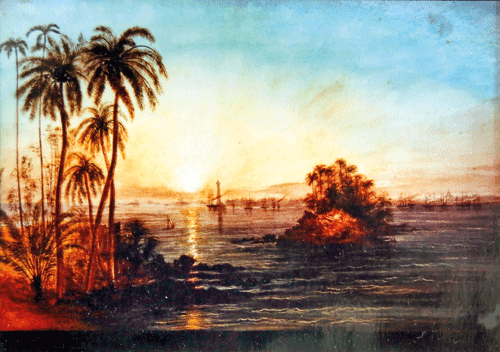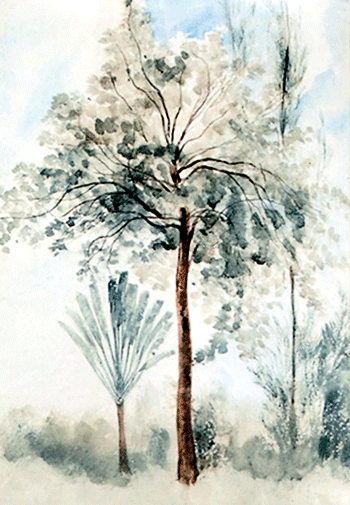An Irish artist in Ceylon

Paintings from Nicholl’s five week tour of Ceylon
I hired a palanquin carriage to convey me to my house, on the Colpetty road, five miles where I arrived nearly barefooted`; my shoes having been worn out, and my clothes hanging in shreds, completely exhausted from excessive fatigue and exposure to the sun’s heat and malaria of the swampy forests with my sketches strapped over my shoulder which I carried them night and day after leaving Anuradhpoora. In the course of the morning I received a note from Dr. Williams, inviting me to dine with Sir Tennent and others of the party, and officers of the Royal artillery, all of who were glad of my return. I retired early sick and travel worn and the following morning found me dangerously ill of Jungle fever. Thus terminated my sketching tour through the forest of Ceylon, the most interesting I ever had in my life and although attended with both danger and fatigue, yet the enjoyment which I derived from it far more than compensated for the hardship of the journey, and will for ever considered by me, the most delightful of all my sketching excursions, either at home or distant lands
(From-A Sketching tour of Five Weeks in the Forests of Ceylon , its ruined temples, colossal statues, tanks dagobahs – Dublin University Magazine. 1852]
With these closing comments by Andrew Nicholl, the Irish artist summed up his two-part article published in the Dublin University Magazine, recalling it as the most delightful and exciting five-week sketching tour, during July and August 1848. He travelled mostly on foot during this arduous journey and faced several life threatening incidents. Also in his own opinion, the most outstanding, the artist undertook ever in his career. On this journey, Nicholl surveyed the archaeological sites of Gadaladeniya, Kandy, Dambulla, Sigiriya, Polonnaruwa and Anuradhapura all the while documenting these sites with detailed drawings.
In 1979, by a series of fortunate events I managed to acquire the very album of drawings, which Nicholl described “with my sketches strapped over my shoulder which I carried them night and day after leaving Anuradhpoora”.
After he left Sri Lanka in June 1849 and made his way to England Nicholl would continue to improve and work on the sketches he executed on this five-week tour and produced several watercolours numbering over a 100. Over one and a half centuries this album of drawings Nicholl owned would changed hands regularly. Soon after Nicholl returned to London in1849 he lent several sketches as well as this album to Colonial Secretary Sir Emerson Tennent who requested the artist to supply him with illustrations for his book Ceylon; an Account of the Island, Physical Historical and Topographical etc.- The album was in the offices of Longmans the publishers who undertook the two volume work which was released in 1859 and republished in five editions by 1860.
 All the illustrations of the archaeological sites in Tennent’s two volume publication numbering 16 wood engravings were based on Nicholls’ original sketches extracted from this very same album of the five-week tour in July-August 1848.
All the illustrations of the archaeological sites in Tennent’s two volume publication numbering 16 wood engravings were based on Nicholls’ original sketches extracted from this very same album of the five-week tour in July-August 1848.
1848 proved a disastrous period for the Colony, approaching three decades of British rule.
The Colonial administration imposed several discriminatory taxes, and promulgated a series of laws, probably the harshest known in this country. Tennent’s offhanded, humiliating approach in dealing with the Kandyan peasants who were most affected by such discriminatory legislation and moreover other public’s grievances led to a catastrophic series of events, culminating in the 1848 Rebellion.
In the first week, the Colonial Secretary Emmerson Tennent embarked on an official tour of the interior. The principal purpose according to the Government’s claim was to ascertain the feelings of the peasantry in the outlying districts and listen to their complaints and their reluctance to pay the newly levied taxes.
Although Tennent was the principal figure in the mounting crisis he was not to be distracted. Tennent was probably seeking the assistance,from his artist friend in the form of illustrations for his forthcoming work. So he turned to Nicholl both as a patron and friend from Belfast days. With other plans in mind he invited Nicholl and two others –Dr. Gardner, Superintendent of the Royal Botanical Gardens, Peradeniya, and Dr. Williams, Royal Artillery. The three of them left Colombo on July 8, 1848.
His name was James Emmerson and he was the son of William Emmerson born in North Street Belfast. He retained this name till age 23, when he married an heiress, the only daughter of a wealthy banker, Letitia Tennent and took her surname. Tennent was a contemporary of Nicholl, both born in Belfast and in the same year -1804. Educated in Belfast he later entered Trinity College Dublin but his outside interests was so varied, they disrupted his studies and he left without a degree. As a prolific writer he often contributed to The Northern Whig newspaper where he often met Nicholl who was working there as a compositor in the letterpress department. Both Tennent and Nicholl who became close friends were products of the social and political liberalism that swept through Belfast in the 1820s.
Their interest in art and politics often would converge and Nicholl was a regular visitor to the Tennent household and was intimate with his sister, who composed a sonnet for him.
Tennent entered Parliament at a very young age at 28 as an M.P. for Belfast and went on to have a meteoric career in the Home Government. By November 29, 1845 he was posted to Ceylon as the Colonial Secretary, the youngest to hold the post. By April 18, 1847, he was promoted to the highest post in the land as Lieutenant Governor.
Tennent holding the exalted position as the Colonial Secretary had an influential role to play as the President of the Schools Commission, which supervised and managed the Colombo Academy and other state funded schools.
In sharp contrast Nicholl was born to working class parents, the second son of Henry Nicholl, a boot and shoemaker and his wife Dorothy. Born on April 4th 1804 in the poorer district of Belfast in No 5/7 Church Lane, he started working in his early teens. His eldest brother William was born on December 11, 1794 and encouraged the younger Andrew to take up painting; but he died at the comparative young age of 46[1840].Mary Ann Nicholl was his only sister (from present evidence) and was alive in 1901. Andrew Nicholl married in 1840 Ann Redden (Presbyterian church). Ulster museum in Belfast has six portraits of the Nicholl family and none others are known to exist in Ireland.
At 18, Nicholl was apprenticed as a compositor (one who arranges typefaces for printing) to the Belfast Printer Francis Dalzell Finlay, the founder of the Belfast newspaper The Northern Whig. One of the news- paper’s early contributors was young James Emmerson.
Nicholl’s early training was in the Letterpress Department and he worked there for seven years-but during these years he also engaged his natural talent for topographical drawing and as a landscape painter. By the early 1820’s Nicholl had earned a reputation in Belfast as an illustrator and printer of Irish landscapes of his neighbourhood.

Andrew Nicholl
In the 1830s, Nicholl moved to London from Belfast only making short visits to Ireland . He visited the few galleries opened to the public particularly the Dulwich Gallery. Here he made studies of the works of Cuyp de Wint and. J.M.W. Turner, the latter whose expressionist style he deeply admired. In 1832 he exhibited at the Royal Academy and in the same year moved to Dublin to exhibit there for the first time at the Royal Hibernian Academy (RHA). In 1837 he was elected as an Associate of the R.H.A and was elected as a full member when the Academy’s new charter extended its membership. Often Nicholl inscribed his drawings and water colour sketches in Ceylon with his name and acronym A.R.H.A. This is an useful indicator with other clues which help to date some of these works. In the same year he exhibited one of his watercolours-“Study from Nature” at the Royal Academy in London.
He was one of the team of artists selected to illustrate the magnificent work, Hall’s Ireland which contains over 100 hundred wood engravings by Andrew Nicholl based on his drawings. Many of these works reflected Nicholl’s interest in the antiquities including buildings , monuments and interesting landscapes of the Irish coastline. His favourite medium in Ireland as well as later in Ceylon was pencil on buff tinted paper and occasionally pen and ink sketches. He successfully developed this technique to a high technical standard when sketching Ceylon’s ancient Buddhist sites.
By 1846 Nicholl’s fortune took an upturn. As early as February 1846, a teaching post was advertised at the behest of the Schools Commission founded in 1841.The Schools Commission, managed and supervised the Colombo Academy and other state aided schools.The Commission made a request supported by the Government in Colombo to the Colonial Office , in London for a teacher to be sent from England to train students in landscape painting, scientific drawing and design for the Colombo Academy (now Royal College). The Commission felt there was a great need for training young school leavers to take up employment in the field of engineering and surveying
As the dispatch by the Governor Colin Campbell in Colombo makes clear to the Colonial Office in London
“What is wanted is not a person to teach practical surveying as suggested in the application of Mr. Boake of the Principal of the Colombo Academy, but an artist with a thorough knowledge of landscape who can instruct the pupils to prepare colour maps and Surveying and Engineering plans and this step once acquire , they will transfer to the Surveyors and Engineering Offices where the elementary and scientific instruction can be much more practically and effectually conveyed”
The dispatch goes on to add; “Ceylon is remarkable for the skill of the natives in Cabinet work and carving on wood , in which they rival the Chinese; but their utter knowledge destitution of any lack of design renders their talents comparatively valueless, while its diffusion would give rise to a profitable branch of manufactures.
The same applies to their work in Jewelry and the precious metals as well as other branches.”
Governor Campbell also felt the pressing need that the selected candidate teacher should have an extra attribute;
“I would likewise recommend that in addition to the services in the Academy, it should be part of his duties to give instruction at a nominal rate to such native artisans and tradesmen as might add a knowledge of design to the exercise of their several handicraft”.
By the middle of 1846 the Colonial Office, London advertised for a candidate for the post of teacher for landscape painting, scientific drawing and design and the Secretary to the Colonies, William Gladstone informed the authorities in Colombo that had already interviewed the applicant Andrew Nicholl and had been selected him to the post as teacher of Drawing at the Colombo Academy.
He was entitled to an annual salary of £ 400.Nicholl was also advised by the Schools Commission that he should bring along with him the necessary art material such as paper, and water colours required for his students to last at least one academic year as many of these items were unavailable in the country.
Nicholl embarked from Falmouth, England on the vessel the Precursor, a paddle steamer (it could use both sail and steam) on August 20, 1846 and disembarked at Galle by September 26, the same year.
( Part II next week)


